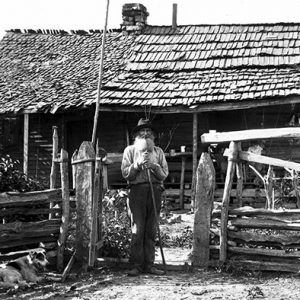calsfoundation@cals.org
Sandtown (Independence County)
Sandtown is an unincorporated community of about twenty families located on Sandtown Road in Jefferson Township about five and a half miles west-southwest of Cave City (Sharp and Independence counties) and about nine and a half miles north of Batesville (Independence County). Local historian Charles Prier believes the settlement’s name comes from the white sand (or silica) found on the sandbar at the confluence of Sullivan Creek and Dry Creek in Sandtown.
By 1849, a large range of manganese ore deposits had been discovered in northwestern Independence County with a spillover into Sharp, Izard, and Stone counties. This discovery came to be labeled the Batesville District, with Cushman (Independence County) at its center; the district also contained Sandtown. William Einstein of St. Louis, Missouri, established a mining operation in about 1868 in a sparsely populated wooded area on what is now known as Polk Southard Mine, about five and a half miles west of present-day Sandtown. In 1885, the Keystone Mining Company (owned by Andrew Carnegie) and the St. Louis Mining Company began operations in the Southard Hill region. This marked the beginning of significant mining in the area. Pool Prospect (a prospect is a manganese ore “dig”) near Pool Chapel is just north of Sandtown, while Pritchett Prospect, Roseborough Mine, Rowe Field Mine, Rogers Mine, Reed Mine, and Roach Mine are located in the Sandtown Road area between Sandtown and Cushman.
A post office was opened in Sandtown in 1882, with Samuel Pruitt appointed postmaster. During that time, Sandtown was a booming community, albeit a small one. John Marion Smith, considered by many to have been the founder of the settlement, operated the store with the post office and became postmaster in 1919. Business records show that one could buy an array of items at the store, from shoes to snake oil. One of Smith’s brothers had a blacksmith shop that also contained facilities for making wagons. The Smith brothers farmed and were noted for their canning activities. Sandtown also had a gin and a sawmill during this time. John Smith and his wife, Martha Spivey Smith, are buried in Lee’s Cemetery at Sandtown.
Started around the beginning of the twentieth century, Wolf School served the educational needs of Sandtown, grades 1–8. It was still active in 1936 but merged with the Cave City School District in the 1940s because none of the school bus drivers wanted to cross the old wooden bridge on the road to Cushman. The post office remained open until the Great Depression, finally closing in 1935.
Much land was leased in the Sandtown area between 1949 and 1958 for manganese mining after the federal government initiated a policy to stockpile manganese, which was considered of importance to national security as a significant alloy in making steel. This created an economic boom for the area during the 1950s. By this time, advances in technology allowed strip mining using heavy equipment instead of old methods of shafts and tunnels. The last ore was mined in the Batesville District in 1959, when the federal government phased out its national security program of stockpiling manganese, which officially ended in 1960, and steel makers in the United States started depending on imported ore.
The Westmoreland Manganese Corporation in 1952 obtained several Quonset hut buildings from World War II army surplus in which to process manganese ore from their mines. These abandoned huts still stand and can be seen from Sandtown Road.
The abandoned Lee’s Chapel and Masonic Hall sits next to Lee’s Cemetery and was placed on the National Register of Historic Places on May 10, 2001. It is the only known concrete-block church in the northwestern part of the county. The building was erected in 1946 by the Lee’s Chapel Methodist Church as a joint project with Montgomery Lodge No. 360 of the Masons. The two-story building has a belfry on top with a rear outside stairway that leads to the upstairs masonic hall. The historic structure, because of its isolation, is a frequent target of vandals. The lodge has moved to Cave City.
The old store on Sandtown Road closed in the mid-1980s but stood for many years; it burned in spring 2019. Visibly, about all that is left of the town is the road that runs through it. The Sandtown Homecoming/Singing is held each year on the first Sunday in June.
For additional information:
Crain, Tracy L. “Sandtown in Independence County: Once Abundant with Commerce.” Arkansas Democrat-Gazette, February 10, 2002.
Lovett, John. “Sandtown’s Foothills Were Once Booming with ‘Mountain Ore.’” Arkansas Democrat-Gazette, May 21, 2000, p. 6S.
McGinnis, A. C. “A History of Independence County, Ark.” Special issue. Independence County Chronicle 17 (April 1976).
Shiras, Tom. “Manganese Mining in Arkansas.” Engineering and Mining Journal 105 (December 22, 1917).
Smith, Jim, and Becky Wood. The Cushman Manganese Mines and the Batesville Manganese District Arkansas. N.p.: 1995.
Spier, William. “A Social History of Manganese Mining in the Batesville District of Independence County.” Arkansas Historical Quarterly 36 (Summer 1977): 130–157.
Kenneth Rorie
Van Buren, Arkansas
 John Wesley Bruce
John Wesley Bruce  Independence County Map
Independence County Map  Lee's Chapel
Lee's Chapel  Steam Boiler
Steam Boiler  Sandtown Store
Sandtown Store  Sandtown Road Building
Sandtown Road Building 



Comments
No comments on this entry yet.